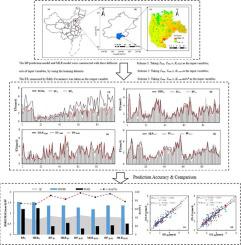Journal of Hydrology ( IF 5.9 ) Pub Date : 2021-02-23 , DOI: 10.1016/j.jhydrol.2021.126104 Xin Han , Zheng Wei , Baozhong Zhang , Yinong Li , Taisheng Du , He Chen

|
Accurate prediction of crop evapotranspiration (ETc) can provide a scientific basis for improving water use efficiency, rational allocation of water resources, and sustainable management of ecosystems. However, conventional statistical methods have the limited application in some regions, because of the complex relationships (nonlinear, linear, exponential, etc) between ETc and its each driving factor. This paper illustrated the utility of the back-propagation neural network (BP) model for ETc prediction and compared the performance of this model with that of the multiple linear regression technique. Combined with the ETc measured by Eddy Covariance and the meteorological data, three-layer BP models, trained by the Levenberg-Marquardt algorithm, were developed with a 4–10-1 architecture (corresponding to four, ten, and one nodes in the input, hidden, and output layers, respectively). The BP models were trained and validated in the MATLAB environment, with three different combinations of maximum air temperature, minimum air temperature, sunshine hours, crop coefficient (Kc), and precipitation. A high correlation was observed between the values measured by Eddy Covariance and those predicted by BP, with a higher coefficient of determination (0.87) and accuracy (91.44%) than that achieved by the multiple linear regression model (0.79 and 82.96%, respectively). Furthermore, the performance of the BP models could be improved substantially by including the dynamic change of Kc and the effect of precipitation, which suggested that these two factors were crucial variables in modeling ETc by BP approaches. In testing sets, the BP model that considered the dynamic change of Kc was found to be superior to the BP model that considered the crop coefficient recommended by FAO-56, with prediction accuracy increased by 19%. Additionally, the accuracy of the BP prediction models that considered the dynamic change of Kc and the effect of precipitation were higher than 95%. Moreover, the BP prediction model in typical weather with precipitation was superior to the BP model in typical weather with no precipitation. The results obtained would be helpful for obtaining the ETc more consistent with the actual growth status of the crop, thereby providing a scientific basis for improving water management during crop production.
中文翻译:

反向传播神经网络模型中考虑作物系数动态变化和降水效应的作物蒸散量预测
作物蒸散量(ET c)的准确预测可以为提高用水效率,合理分配水资源和可持续管理生态系统提供科学依据。但是,由于ET c及其每个驱动因子之间存在复杂的关系(非线性,线性,指数等),因此传统的统计方法在某些地区的应用受到限制。本文说明了反向传播神经网络(BP)模型在ET c预测中的实用性,并将该模型的性能与多元线性回归技术进行了比较。与ET c结合根据Eddy Covariance和气象数据进行的测量,由Levenberg-Marquardt算法训练的三层BP模型是采用4–10-1架构开发的(对应于输入,隐藏和输入中的四个,十个和一个节点)输出层)。在MATLAB环境中对BP模型进行了训练和验证,采用了三种不同组合,分别是最高气温,最低气温,日照时间,作物系数(K c)和沉淀。涡流协方差测得的值与BP预测的值之间具有高度相关性,与多元线性回归模型(分别为0.79和82.96%)相比,确定系数(0.87)和准确性(91.44%)高。 。此外,通过包括K c的动态变化和降水影响,可以大大提高BP模型的性能,这表明这两个因素是通过BP方法建模ET c的关键变量。在测试集中,考虑了K c动态变化的BP模型被发现优于考虑了FAO-56建议的作物系数的BP模型,预测精度提高了19%。此外,考虑到K c的动态变化和降水影响的BP预测模型的准确性高于95%。此外,在有降水的典型天气中的BP预测模型要优于在无降水的典型天气中的BP模型。获得的结果将有助于获得更符合作物实际生长状况的ETc,从而为改善作物生产过程中的水分管理提供科学依据。











































 京公网安备 11010802027423号
京公网安备 11010802027423号